Magnesium Sulphate Market
Magnesium Sulphate Market Size and Share Forecast Outlook 2025 to 2035
Magnesium sulphate market is projected to grow from USD 0.9 billion in 2025 to USD 1.6 billion by 2035, at a CAGR of 5.7%. Agriculture Grade will dominate with a 34.6% market share, while agriculture will lead the application segment with a 39.2% share.
Magnesium Sulphate Market Forecast and Outlook 2025 to 2035
The global magnesium sulphate market is set to grow from USD 0.91 billion in 2025 to USD 1.59 billion by 2035, adding USD 0.68 billion in new revenue and advancing at a CAGR of 5.7%. Growth is driven by escalating demand for agricultural nutrients, expanding pharmaceutical production infrastructure across regulated markets, and accelerating fertilizer application requirements among farming organizations seeking yield optimization solutions.
Magnesium sulphate technologies are increasingly recognized as essential compounds for agricultural practitioners, offering precise nutrient supplementation capabilities, soil deficiency correction, and comprehensive crop productivity characteristics compared to alternative magnesium source approaches.
Quick Stats for Magnesium Sulphate Market
- Magnesium Sulphate Market Value (2025): USD 0.91 billion
- Magnesium Sulphate Market Forecast Value (2035): USD 1.59 billion
- Magnesium Sulphate Market Forecast CAGR: 5.7%
- Leading Grade in Magnesium Sulphate Market: Agriculture Grade (34.6%)
- Key Growth Regions in Magnesium Sulphate Market: Asia Pacific, North America, and Latin America
- Top Players in Magnesium Sulphate Market: K+S Group, Compass Minerals, Giles Chemical, Aldeon Chemical, PQ Corporation
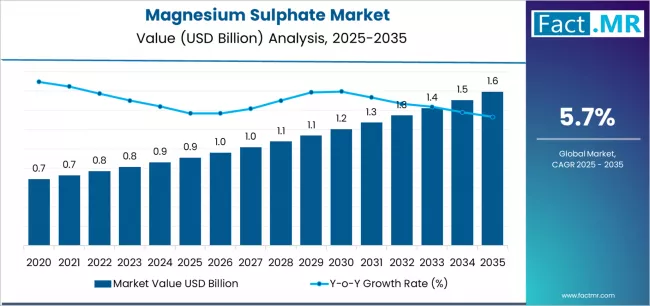
Agriculture grade formulations dominate the market, favored in farming and horticulture environments for their established soil amendment properties, providing magnesium delivery mechanisms, sulphur supplementation capabilities, and nutrient balance across diverse crop applications and cultivation demographics.
Agriculture applications remain fundamental in consumption protocols where fertilizer formulation and foliar spray utilization match agronomic requirements and crop performance confidence standards.
Pharmaceuticals sectors are advancing among application categories as specialized active pharmaceutical ingredient facility networks expand and therapeutic formulation infrastructure increases accessibility in production-convenient locations with medical grade purity structures.
Geographic concentration demonstrates dynamic growth patterns with China and India leading expansion, supported by rising agricultural production capacity, soil health consciousness expansion among farming populations, and fertilizer manufacturing establishment programs in production centers.
The USA, Brazil, Germany, Japan, and UK demonstrate robust development through established magnesium sulphate trade ecosystems, regulatory framework maturity for agricultural standards, and continued acceptance of nutrient supplementation procedures. Competitive advantage is consolidating around purity grade profiles, solubility characteristic documentation, application versatility compatibility, and integrated nutrient solution portfolios rather than standalone magnesium compound formulations alone.
The first half of the decade will witness the market climbing from USD 0.91 billion to USD 1.23 billion, adding USD 0.32 billion in value, which constitutes 47% of the total forecast growth period. This phase will be characterized by the continued dominance of agriculture grade methodologies in farming settings, combined with accelerating adoption of medical grade technologies in pharmaceutical manufacturing applications where purity validation and therapeutic compliance create favorable regulatory approval outcomes.
The latter half will witness sustained expansion from USD 1.23 billion to USD 1.59 billion, representing an addition of USD 0.36 billion or 53% of the decade's growth, defined by broadening acceptance of specialty processed formulations and integration of precision application platforms across mainstream agricultural production facilities.
Where revenue comes from - Now Vs Next (industry-level view)
| Period | Primary Revenue Buckets | Share | Notes |
|---|---|---|---|
| Today | Agriculture Grade | 34.6% | Nutrient dominance |
| Agriculture Application | 39.2% | Primary use segment | |
| Powder Form | 36.8% | Leading formulation | |
| Soil Nutrient Enhancement | 15.1% | Core agricultural use | |
| Fertilizer Application | 17.5% | Direct nutrient delivery | |
| Future (3-5 yrs) | Medical Grade Products | 38-44% | Pharmaceutical expansion |
| Liquid Solutions | 32-38% | Application convenience | |
| Specialty Crops | 28-34% | Premium agriculture | |
| Food Grade Applications | 22-28% | Processing growth | |
| Foliar Spray Systems | 24-30% | Precision delivery | |
| Organic Certification | 18-24% | Sustainable farming | |
| Emerging Markets | 35-41% | Agricultural expansion |
Magnesium Sulphate Market Key Takeaways
At-a-Glance Metrics
| Metric | Value |
|---|---|
| Market Value (2025) → | USD 0.91 billion |
| Market Forecast (2035) ↑ | USD 1.59 billion |
| Growth Rate ★ | 5.7% CAGR |
| Leading Grade → | Agriculture Grade |
| Primary Application → | Agriculture |
The market demonstrates exceptional fundamentals with Agriculture Grade capturing a commanding 34.6% share through superior soil amendment characteristics, established nutrient delivery advantages, and proven crop response profiles across farming applications. Agriculture drives primary application demand at 39.2% share, supported by established fertilizer infrastructure and crop yield requirements that maintain production optimization across diverse cultivation segments.
Geographic concentration remains anchored in Asia Pacific and North America with emerging market leadership through agricultural production expansion and nutrient management infrastructure development, while developed markets show accelerated adoption rates driven by specialty crop demographics and precision agriculture procedure preferences.
Imperatives for Stakeholders in Magnesium Sulphate Market
Design for purity and application versatility, not just magnesium delivery
- Offer complete nutrient solutions: agriculture grade products + solubility optimization + application guidance + deficiency correction systems + agronomic support platforms.
- Preconfigured nutrient packages: fertilizer blend specifications, foliar spray configurations, soil amendment programs, and combination nutrient protocols for diverse farming requirements.
Regulatory readiness for multi-grade applications
- Comprehensive purity documentation, quality compliance systems, and production infrastructure (batch traceability, contaminant control, food safety management protocols).
Affordability-by-design approach
- Cost-optimized product portfolios, flexible application pricing models, farmer loyalty programs, and transparent total nutrient cost documentation.
Technical support-focused market penetration
- Established agronomic consultation workshops + comprehensive certification programs (soil testing, application rates, deficiency management); direct farmer engagement for relationship development and nutrient confidence building.
Segmental Analysis
The market segments by grade into agriculture grade, industrial grade, medical grade, food grade, feed grade, and Epsom salt/consumer grade, representing the evolution from basic commodity production toward specialized purity with application-specific formulation, regulatory compliance, and quality assurance characteristics.
The application segmentation divides the market into agriculture (39.2%), pharmaceuticals, food and beverage, personal care and cosmetics, industrial processing, and others, reflecting distinct usage objectives for crop nutrition and soil amendment versus therapeutic formulation and processing applications. The form segmentation shows powder's commanding 36.8% position, followed by granules, liquid solution, and crystals, demonstrating varied physical form specialization levels and application convenience concentrations.
By Grade, Which Category of Magnesium Sulphate will be Dominant?
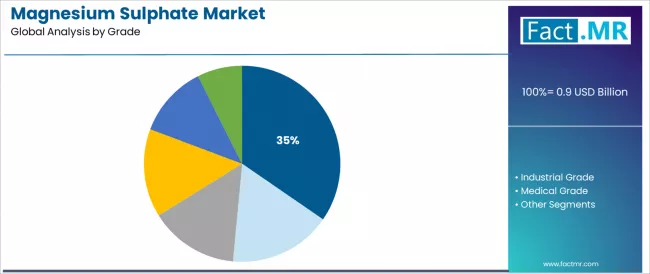
Agriculture grade magnesium sulphate commands the leading position in the magnesium sulphate market with a 34.6% market share through superior soil amendment characteristics, including magnesium deficiency correction capacity, sulphur nutrient provision, and crop yield enhancement pathways that enable farmers to achieve predictable agronomic outcomes across varied soil conditions and diverse cultivation demographics.
The segment benefits from nutrient availability advantages through water solubility, rapid crop response results without lengthy application cycles, and established agronomic documentation without requiring extensive soil testing infrastructure. Advanced processing technology enables purity level optimization, particle size distribution variation, and coating technology customization, where nutrient efficiency and application economy represent critical agricultural performance requirements.
Soil nutrient enhancement applications hold significant share within the agriculture grade segment, appealing to farmers seeking comprehensive magnesium delivery capabilities for deficiency correction. Agriculture grade products differentiate through proven crop response profiles, farmer familiarity advantages, and integration with established fertilizer application protocols that enhance agronomic confidence while maintaining cost-effective nutrient outcomes for diverse farming applications.
Key market characteristics:
- Advanced solubility properties with rapid dissolution and nutrient availability for efficient crop uptake operations
- Superior nutrient balance, enabling magnesium and sulphur delivery for comprehensive plant nutrition optimization
- Comprehensive application flexibility, including soil incorporation, foliar spray, and fertigation systems for multiple delivery methods
Why does Industrial Grade Magnesium Sulphate Show Growth Prospects?
Industrial grade magnesium sulphate maintains specialized market position through processing characteristics and chemical reaction capabilities. These products appeal to manufacturers and processors seeking reliable magnesium source with comprehensive purity standards, offering predictable performance patterns and consistent material behavior through controlled production processes. Adoption is driven by chemical manufacturing applications, emphasizing intermediate compound production and process optimization through industrial-specification systems.
How does Agriculture Application Dominance Shape Usage Preferences in Magnesium Sulphate?
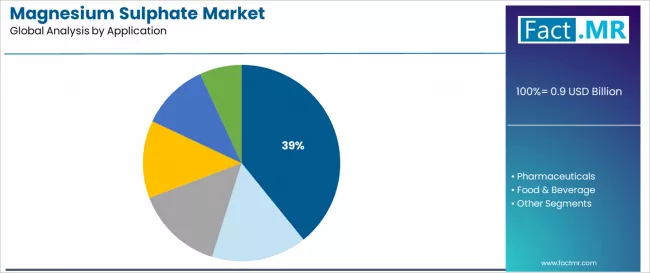
Agriculture demonstrates application leadership in the magnesium sulphate market with a 39.2% share due to widespread crop nutrition requirements and established focus on fertilizer formulation, foliar spray application, and soil conditioning that maximizes yield performance while maintaining nutrient balance characteristics.
Farmers and agronomists prioritize agricultural applications for magnesium deficiency correction, sulphur supplementation, and integration with established crop nutrition programs that enables coordinated fertilizer experiences across multiple growing seasons. The segment benefits from substantial agronomic research and crop response documentation that emphasizes magnesium sulphate-based approaches for nutrient management across diverse agricultural systems.
Fertilizer application captures significant share within the agriculture segment, demonstrating farmer preference for direct nutrient delivery methods. Specialty crop expansion incorporates magnesium sulphate as essential micronutrient components for high-value production systems, while precision agriculture adoption increases targeted application that meets efficiency requirements and ensures environmental stewardship capabilities.
What drives Pharmaceuticals Adoption in Therapeutic Formulation Applications?
Pharmaceuticals capture substantial application share through comprehensive requirements in active pharmaceutical ingredient production, parenteral solution formulation, and therapeutic dosage optimization. These applications demand sophisticated purity protocols capable of achieving USP/EP standards while providing consistent pharmaceutical performance and regulatory documentation, appealing to manufacturers and formulators seeking evidence-based therapeutic advantages beyond industrial-grade approaches.
By Form, Which Category of Magnesium Sulphate is the Most Demanded?
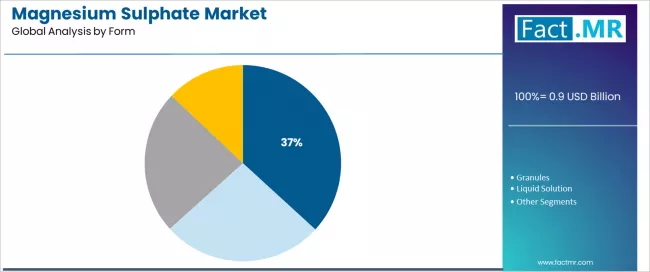
Powdered magnesium sulphate forms leadership with a 36.8% share due to comprehensive application versatility and sustained focus on ease of handling, dissolution convenience, and formulation flexibility that maximizes processing compatibility while maintaining appropriate cost-performance standards.
Manufacturers and end-users prioritize powder form for rapid dissolution characteristics, straightforward blending capabilities, and integration with established production equipment that enables coordinated formulation experiences across multiple application categories. The sector benefits from substantial production infrastructure maturity and packaging optimization campaigns that emphasize powder-based delivery for mainstream industrial and agricultural applications.
Agricultural fertilizer expansion incorporates powder form as accessible nutrient components for blending operations, while pharmaceutical manufacturing increases fine powder specifications that meet purity requirements and ensure uniform formulation capabilities.
Form dynamics include:
- Strong growth in water-soluble powder requiring instant dissolution and complete nutrient availability arrangements
- Increasing adoption in technical powder applications for industrial processing and chemical synthesis positioning
- Rising integration with specialty processed powder platforms for pharmaceutical formulation and therapeutic development
How is Liquid Magnesium Sulphate Advancing Application Convenience Requirements?
Liquid magnesium sulphate is experiencing an increased share through established fertigation frameworks, complex application system capabilities, and integrated precision delivery protocols.
The segment demonstrates specialized application expertise across diverse irrigation technologies, with advanced concentration control applications and uniform distribution infrastructure gaining traction in modern farming programs while storage stability frameworks drive continued product development requiring careful balance between concentration optimization and handling safety assurance.
What are the Drivers, Restraints, and Key Trends of the Magnesium Sulphate Market?
| Category | Factor | Impact | Why It Matters |
|---|---|---|---|
| Driver | Rising agricultural intensification & crop nutrient demands (yield optimization, soil health) | ★★★★★ | Crop production requirements enable magnesium sulphate demand for nutrient deficiency correction; increasing agricultural productivity drives fertilizer adoption across farming markets and diverse crop segments. |
| Driver | Growth in pharmaceutical manufacturing and parenteral nutrition (therapeutic applications, medical formulations) | ★★★★★ | Drives demand for high-purity magnesium systems and USP-grade protocols; facilities providing validated pharmaceutical outcomes gain competitive advantage in healthcare-focused production segments. |
| Driver | Expanding specialty crop cultivation and precision agriculture (horticulture growth, micronutrient focus) | ★★★★☆ | Farmers demand effective nutrient solutions and documented crop response systems; precision agriculture visibility expanding addressable segments beyond traditional fertilizer demographics and commodity crop clientele. |
| Restraint | Price volatility & raw material availability (mining constraints, production costs) | ★★★★☆ | Cost-conscious farmers face budget limitations and application frequency constraints, restricting product adoption and affecting nutrient penetration in resource-limited operations and price-sensitive market segments. |
| Restraint | Alternative magnesium sources & nutrient competition (dolomite, magnesium oxide) | ★★★☆☆ | Farmers face product selection complexity and comparative economics; increases decision barriers and affects adoption penetration in traditional farming systems and cost-optimized nutrient programs. |
| Trend | Organic farming growth & certified input requirements (sustainable agriculture, organic certification) | ★★★★★ | Growing farmer demand for organic-approved nutrient sources and certified sustainable inputs beyond conventional fertilizer systems; organic compatibility becomes core differentiation strategy for premium agricultural positioning. |
| Trend | Precision application & fertigation technologies (controlled release, targeted delivery) | ★★★★☆ | Agriculture evolving beyond broadcast application toward precision nutrient management; technology positioning drives enhanced efficiency and reduced environmental impact in sophisticated farming environments. |
Analysis of the Magnesium Sulphate Market by Key Countries
The magnesium sulphate market demonstrates robust regional growth dynamics with emerging leaders including China (6.9% CAGR) and India (6.7% CAGR) driving expansion through agricultural production programs and fertilizer manufacturing infrastructure development. Strong performers encompass Brazil (6.4% CAGR), USA (5.8% CAGR), and Germany (5.5% CAGR), benefiting from established agricultural nutrient infrastructure and specialty crop demographics. Developed markets feature Japan (5.2% CAGR) and UK (4.9% CAGR), where precision agriculture normalization and pharmaceutical manufacturing expertise support consistent growth patterns.
Regional synthesis reveals Asian markets leading adoption through comprehensive agricultural capacity positioning and fertilizer consumption expansion, while Western countries demonstrate measured growth potential supported by specialty crop preferences and pharmaceutical production influence. Latin American markets show solid development driven by agricultural intensification and export crop infrastructure.
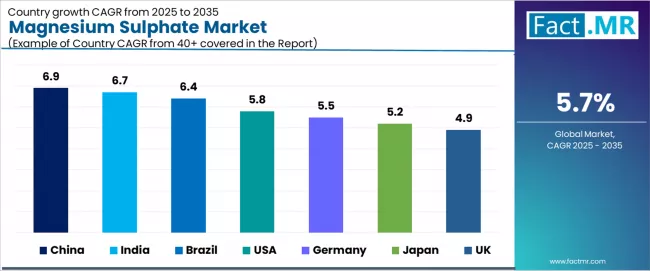
| Region/Country | 2025 to 2035 Growth | How to win | What to watch out |
|---|---|---|---|
| China | 6.9% | Focus on agriculture-grade portfolios | Largest fertilizer market with expanding crop production |
| India | 6.7% | Lead with affordable nutrient positioning | Agricultural expansion and micronutrient awareness growth |
| Brazil | 6.4% | Offer agronomic support strategies | Specialty crop cultivation and export agriculture development |
| USA | 5.8% | Provide pharmaceutical-grade technologies | Diverse applications across agriculture and healthcare sectors |
| Germany | 5.5% | Maintain quality-focused positioning | Pharmaceutical production and specialty agriculture integration |
| Japan | 5.2% | Deliver high-purity solutions | Pharmaceutical manufacturing and precision agriculture adoption |
| UK | 4.9% | Push specialty application programs | Healthcare applications and controlled environment agriculture |
China Drives Fastest Market Growth
China establishes fastest market growth through progressive agricultural production expansion and comprehensive fertilizer manufacturing infrastructure development, positioning magnesium sulphate technologies as essential nutrient solutions in crop cultivation operations and emerging specialty farming facilities.
The country's 6.9% growth rate reflects largest fertilizer market status supporting expanding crop production and growing micronutrient awareness segments that encourage the deployment of cost-optimized magnesium sulphate products in diverse agricultural settings.
Growth concentrates in major agricultural provinces, including Shandong, Henan, and Jiangsu, where farming operations showcase increasing capacity for balanced fertilization adoption that appeals to yield-focused producers demanding validated nutrient supplementation and deficiency correction outcomes.
Chinese agricultural producers are developing standardized application protocols that combine domestic magnesium sulphate production with provincial extension partnerships, including precision agriculture expansion and soil testing laboratory growth.
Distribution channels through agricultural input distributors and fertilizer retailers expand market access, while agronomist certification initiatives support adoption across diverse farm types and crop specialization levels.
India Emerges as Agricultural Nutrient Leader
In Punjab, Maharashtra, and Karnataka regions, farming operations and horticulture enterprises are adopting advanced magnesium sulphate technologies as essential nutrient tools for crop production operations, driven by agricultural expansion momentum combined with micronutrient awareness growth among progressive farmers that emphasizes the importance of balanced fertilization systems. The market holds a 6.7% growth rate, supported by government subsidy programs and soil health initiative investment that promote nutrient adoption for productivity-oriented applications.
Indian farmers are favoring water-soluble formulations that provide comprehensive crop response and agronomic efficiency, particularly appealing in intensive cultivation zones where nutrient management and deficiency correction represent critical production factors.
Market expansion benefits from substantial agricultural extension investment and soil testing facility establishment that enable widespread adoption of evidence-based nutrient management for diverse crop applications. Industry adoption follows patterns established in balanced fertilization excellence, where yield optimization advantages and soil health improvement documentation drive farmer confidence and nutrient program implementation.
Brazil Shows Agricultural Intensification Integration
Brazil's expanding agricultural market demonstrates progressive magnesium sulphate adoption with documented crop nutrition emphasis in application methodology and nutrient management protocol execution through specialized farming operations and established agricultural enterprises. The country maintains a 6.4% growth rate, driven by specialty crop cultivation expansion combined with export agriculture development supporting competitive production operations.
Major agricultural regions, including São Paulo, Minas Gerais, and Paraná, showcase productivity-driven nutrient approaches where magnesium sulphate technologies integrate with established agronomic cultures and comprehensive fertilizer programs to optimize crop quality and maintain international market competitiveness under demanding export standards.
Brazilian farmers prioritize agronomic support solutions and comprehensive crop response validation in nutrient product implementation, creating demand for technically supported products with proven performance characteristics, including foliar application efficiency, soil amendment effectiveness, and crop yield documentation. The market benefits from established coffee and citrus production sectors and expanding vegetable cultivation facilities that provide premium nutrient positioning opportunities and maintain alignment with Brazilian agricultural best practices.
USA Shows Diversified Application Leadership
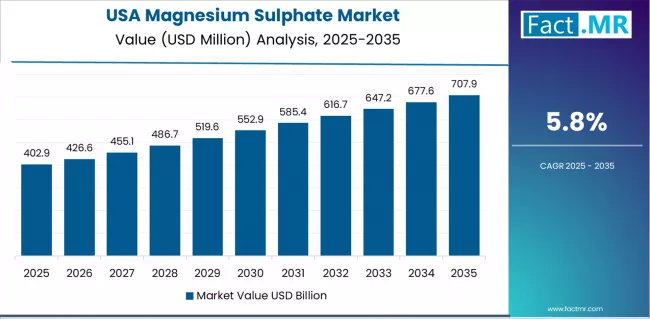
USA establishes diversified application leadership through comprehensive agricultural infrastructure and established pharmaceutical manufacturing ecosystem, integrating magnesium sulphate technologies across specialty crop farms, pharmaceutical facilities, and industrial processing operations.
The country's 5.8% growth rate reflects diverse applications across agriculture and healthcare sectors with sophisticated quality requirements that support widespread deployment of multi-grade magnesium sulphate products in commercial and industrial applications.
Growth concentrates in established agricultural regions including California, Florida, and the Midwest, combined with pharmaceutical clusters where manufacturers showcase advanced purity adoption that appeals to regulatory-focused organizations seeking predictable quality outcomes and comprehensive documentation.
American producers and users leverage established supplier relationships and comprehensive quality system frameworks, including pharmaceutical compliance readiness and agricultural performance validation programs that create application confidence and regulatory assurance. The market benefits from substantial specialty crop production and pharmaceutical manufacturing expansion that encourage premium product purchases while supporting continuous innovation investments and application technology funding.
Germany Shows Pharmaceutical Quality Integration
Germany's advanced industrial market demonstrates sophisticated magnesium sulphate integration with documented quality emphasis in pharmaceutical production and specialty agriculture applications through established manufacturing facilities and precision farming networks. The country leverages pharmaceutical production excellence combined with specialty agriculture integration approaches to maintain a 5.5% growth rate.
Premium production centers, including Bavaria, North Rhine-Westphalia, and Baden-Württemberg, showcase quality-driven application priorities where magnesium sulphate technologies integrate with established pharmaceutical cultures and advanced agricultural practices to optimize product purity and ensure appropriate regulatory compliance.
German manufacturers and farmers prioritize comprehensive quality validation and extensive documentation in magnesium sulphate utilization, creating demand for certified products with thorough specifications, including USP/EP compliance, heavy metal limits, and agricultural effectiveness data. The market benefits from established pharmaceutical manufacturing segments and greenhouse horticulture maturity that provide premium positioning opportunities and compliance with strict German quality regulations.
Japan Demonstrates High-Purity Application Preferences
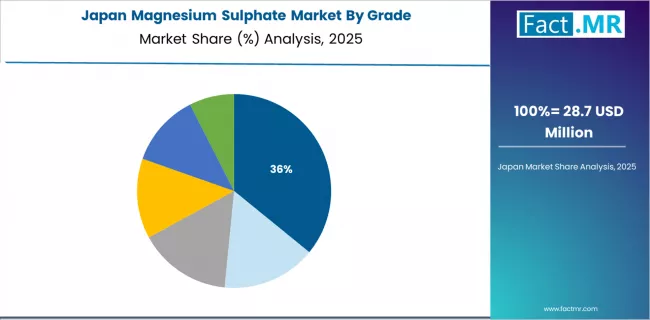
Japan's sophisticated pharmaceutical market demonstrates established magnesium sulphate adoption with documented purity emphasis in therapeutic formulations and precision agriculture through comprehensive pharmaceutical facilities and controlled environment agriculture operations. The country maintains a 5.2% growth rate, reflecting pharmaceutical manufacturing requirements combined with precision agriculture adoption supporting specialized production growth.
Metropolitan pharmaceutical centers, including Tokyo, Osaka, and Nagoya regions, combined with intensive agriculture zones, showcase quality-driven application priorities where magnesium sulphate technologies integrate with established pharmaceutical standards and meticulous agricultural practices to optimize formulation purity and maintain crop quality outcomes under demanding performance requirements.
Japanese manufacturers and farmers prioritize comprehensive purity validation and rigorous contamination control in magnesium sulphate application, creating demand for pharmaceutical-grade products with exceptional quality characteristics, including low heavy metal content, endotoxin control, and validated stability profiles. The market benefits from established pharmaceutical manufacturing reputation and greenhouse cultivation excellence that provide premium positioning opportunities and comply with strict Japanese quality standards.
UK Shows Healthcare Application Leadership
UK's mature pharmaceutical market demonstrates progressive magnesium sulphate integration with documented therapeutic emphasis in parenteral formulations and specialty agriculture through established pharmaceutical manufacturers and controlled environment agriculture facilities. The country maintains a 4.9% growth rate, driven by healthcare applications combined with controlled environment agriculture expansion supporting regional production initiatives.
Key pharmaceutical regions, including England and Scotland, alongside intensive horticulture zones, showcase healthcare-driven demand approaches where magnesium sulphate technologies integrate with established NHS supply systems and advanced growing practices to optimize patient care and maintain agricultural productivity under quality-focused production standards.
The manufacturers and growers prioritize pharmaceutical compliance frameworks and comprehensive application validation in magnesium sulphate utilization, creating demand for medical-grade products with extensive regulatory characteristics, including MHRA approval status, batch certification, and agricultural performance evidence. The market benefits from established pharmaceutical supply chains and greenhouse horticulture sectors that provide quality positioning opportunities and maintain alignment with UK healthcare and agricultural regulations.
Europe Market Split by Country
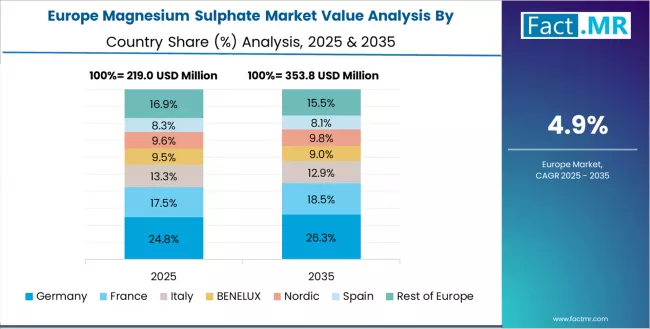
The magnesium sulphate market in Europe is projected to grow from USD 185.2 million in 2025 to USD 297.9 million by 2035, representing 20.3% of the global market in 2025 and expanding to 18.8% by 2035. Germany is expected to maintain its leadership position with USD 49.6 million in 2025, accounting for 26.8% of the European market, supported by its advanced pharmaceutical manufacturing infrastructure and established specialty agriculture networks.
France follows with USD 35.0 million, representing 18.9% of the European market in 2025, driven by comprehensive pharmaceutical production integration and agricultural nutrient concentration. UK holds USD 32.0 million with 17.3% market share through established healthcare application acceptance and horticulture facility density.
Italy commands USD 26.3 million representing 14.2% share, while Spain accounts for USD 21.5 million or 11.6% in 2025. The rest of Europe region maintains USD 20.7 million, representing 11.2% of the European market, attributed to increasing pharmaceutical adoption in Nordic countries and emerging Eastern European agricultural sectors implementing nutrient management programs.
Competitive Landscape of the Magnesium Sulphate Market
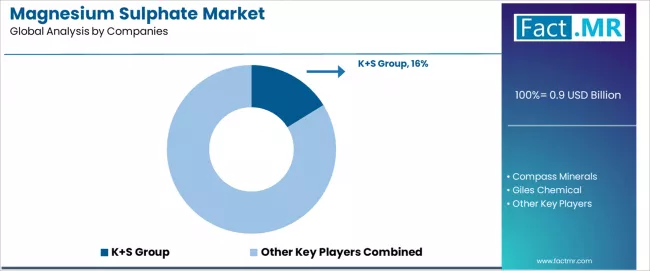
The magnesium sulphate market exhibits a moderately consolidated competitive structure with approximately 40-60 active players operating across global mineral processing networks and regional chemical distribution portfolios. K+S Group maintains market leadership at a 16.2% share, reflecting strong integrated positioning across diverse production facilities with sophisticated global supply strategies.
This competitive landscape demonstrates the maturation of magnesium sulphate production, where established players leverage mining operation advantages, extensive quality control documentation, and multi-grade production programs to maintain dominant positions, while emerging specialty processors and regional manufacturers create niche opportunities through high-purity offerings and application-specific formulation strategies.
Market leadership is maintained through several critical competitive advantages extending beyond mining capabilities and processing portfolios. Global distribution networks enable leading players to navigate diverse quality requirements and access varied customer segments including agricultural cooperatives, pharmaceutical manufacturers, and industrial processors.
Technical support infrastructure and application development program availability represent crucial differentiators in magnesium sulphate categories, where decades of formulation expertise, purity optimization protocols, and agronomic guidance frameworks create purchasing preference among quality-focused customers.
Production efficiency in integrated mining operations, supply chain logistics management, and grade-specific processing control separate major suppliers from smaller competitors, while comprehensive quality documentation addressing purity specifications, analytical methods, and application performance strengthen market position and customer confidence.
The market demonstrates emerging differentiation opportunities in medical grade categories and specialty processed technologies, where traditional agriculture-grade products face competition from purity-focused entrants offering pharmaceutical compliance advantages. However, significant competitive advantages persist in established commodity grade categories through comprehensive production capacity portfolios and customer relationship depth.
Premium positioning strategies with USP/EP certification and pharmaceutical-grade capabilities command margin premiums through superior purity verification and regulatory compliance assurance. Specialized product portfolios combining multiple grades with application-specific formulations create comprehensive positioning that justifies higher price points beyond commodity magnesium sulphate competition. Integrated supply chain offerings emphasizing quality consistency, unified technical support, and cross-grade expertise programs generate brand loyalty and sourcing preferences beyond transactional magnesium sulphate purchases.
| Stakeholder | What they actually control | Typical strengths | Typical blind spots |
|---|---|---|---|
| Global mineral producers | Comprehensive mining operations; processing facilities; distribution networks | Vertical integration; supply reliability; customer relationships; production scale | Innovation speed; specialty grades; application support; regional customization |
| Specialized chemical companies | Purity expertise; pharmaceutical-grade production; quality systems | Product differentiation; medical markets; regulatory credentials; customer loyalty | Production capacity; mining control; price competitiveness; geographic coverage |
| Regional manufacturers | Local production; cost optimization; regional distribution; customer proximity | Affordability positioning; delivery speed; local support; market understanding | Quality certification; pharmaceutical access; international expansion; advanced processing |
| Agricultural distributors | Market access; farmer relationships; application support; logistics | Customer reach; agronomic knowledge; service capabilities; convenience positioning; repeat business | Production control; quality development; pharmaceutical markets; premium positioning |
| Pharmaceutical suppliers | Medical-grade certification; regulatory expertise; quality assurance; healthcare networks | Pharmaceutical credibility; quality standards; compliance programs; documentation strength | Production operations; agricultural markets; commodity economics; price competition |
Key Players in the Magnesium Sulphate Market
- K+S Group
- Compass Minerals
- Giles Chemical
- Aldeon Chemical
- PQ Corporation
- Mani Agro Chem
- Hefei TNJ Chemical Industry Co.
- UMAI Chemical Co.
- Laizhou City Laiyu Chemical Co.
- Yantai Sanding Chemical
Scope of the Report
| Items | Values |
|---|---|
| Quantitative Units (2025) | USD 0.91 billion |
| Grade | Agriculture Grade, Industrial Grade, Medical Grade, Food Grade, Feed Grade, Epsom Salt/Consumer Grade |
| Application | Agriculture, Pharmaceuticals, Food & Beverage, Personal Care & Cosmetics, Industrial Processing, Others |
| Form | Powder, Granules, Liquid Solution, Crystals |
| Regions Covered | North America, Europe, Asia Pacific, Latin America, MEA |
| Countries Covered | China, India, Brazil, USA, Germany, Japan, UK, and 15+ additional countries |
| Key Companies Profiled | K+S Group, Compass Minerals, Giles Chemical, Aldeon Chemical, PQ Corporation, Mani Agro Chem, Hefei TNJ Chemical Industry Co. |
| Additional Attributes | Dollar sales by grade, application, and form categories, regional adoption trends across Asia Pacific, North America, and Europe, competitive landscape with established mineral producers and specialized chemical companies, customer preferences for agriculture-grade methodologies and pharmaceutical compliance, integration with farming operations and pharmaceutical manufacturing facilities, innovations in high-purity processing technologies and application-specific formulations, and development of sophisticated quality systems with enhanced purity profiles and comprehensive regulatory documentation frameworks. |
Magnesium Sulphate Market by Segments
-
Grade :
- Agriculture Grade
- Industrial Grade
- Medical Grade
- Food Grade
- Feed Grade
- Epsom Salt/Consumer Grade
-
Application :
- Agriculture
- Pharmaceuticals
- Food & Beverage
- Personal Care & Cosmetics
- Industrial Processing
- Others
-
Form :
- Powder
- Granules
- Liquid Solution
- Crystals
-
Region :
- North America
- USA
- Canada
- Mexico
- Europe
- Germany
- France
- UK
- Italy
- Spain
- Rest of Europe
- Asia Pacific
- China
- India
- Japan
- South Korea
- ASEAN
- Australia & New Zealand
- Rest of Asia Pacific
- Latin America
- Brazil
- Rest of Latin America
- MEA
- GCC Countries
- South Africa
- Rest of MEA
- North America
Table of Content
- Executive Summary
- Global Market Outlook
- Demand to side Trends
- Supply to side Trends
- Technology Roadmap Analysis
- Analysis and Recommendations
- Market Overview
- Market Coverage / Taxonomy
- Market Definition / Scope / Limitations
- Market Background
- Market Dynamics
- Drivers
- Restraints
- Opportunity
- Trends
- Scenario Forecast
- Demand in Optimistic Scenario
- Demand in Likely Scenario
- Demand in Conservative Scenario
- Opportunity Map Analysis
- Product Life Cycle Analysis
- Supply Chain Analysis
- Investment Feasibility Matrix
- Value Chain Analysis
- PESTLE and Porter’s Analysis
- Regulatory Landscape
- Regional Parent Market Outlook
- Production and Consumption Statistics
- Import and Export Statistics
- Market Dynamics
- Global Market Analysis 2020 to 2024 and Forecast, 2025 to 2035
- Historical Market Size Value (USD Million) Analysis, 2020 to 2024
- Current and Future Market Size Value (USD Million) Projections, 2025 to 2035
- Y to o to Y Growth Trend Analysis
- Absolute $ Opportunity Analysis
- Global Market Pricing Analysis 2020 to 2024 and Forecast 2025 to 2035
- Global Market Analysis 2020 to 2024 and Forecast 2025 to 2035, By Grade
- Introduction / Key Findings
- Historical Market Size Value (USD Million) Analysis By Grade, 2020 to 2024
- Current and Future Market Size Value (USD Million) Analysis and Forecast By Grade, 2025 to 2035
- Agriculture Grade
- Industrial Grade
- Medical Grade
- Food Grade
- Feed Grade
- Epsom Salt/Consumer Grade
- Y to o to Y Growth Trend Analysis By Grade, 2020 to 2024
- Absolute $ Opportunity Analysis By Grade, 2025 to 2035
- Global Market Analysis 2020 to 2024 and Forecast 2025 to 2035, By Application
- Introduction / Key Findings
- Historical Market Size Value (USD Million) Analysis By Application, 2020 to 2024
- Current and Future Market Size Value (USD Million) Analysis and Forecast By Application, 2025 to 2035
- Agriculture
- Pharmaceuticals
- Food & Beverage
- Personal Care & Cosmetics
- Industrial Processing
- Others
- Y to o to Y Growth Trend Analysis By Application, 2020 to 2024
- Absolute $ Opportunity Analysis By Application, 2025 to 2035
- Global Market Analysis 2020 to 2024 and Forecast 2025 to 2035, By Form
- Introduction / Key Findings
- Historical Market Size Value (USD Million) Analysis By Form, 2020 to 2024
- Current and Future Market Size Value (USD Million) Analysis and Forecast By Form, 2025 to 2035
- Powder
- Granules
- Liquid Solution
- Crystals
- Y to o to Y Growth Trend Analysis By Form, 2020 to 2024
- Absolute $ Opportunity Analysis By Form, 2025 to 2035
- Global Market Analysis 2020 to 2024 and Forecast 2025 to 2035, By Region
- Introduction
- Historical Market Size Value (USD Million) Analysis By Region, 2020 to 2024
- Current Market Size Value (USD Million) Analysis and Forecast By Region, 2025 to 2035
- North America
- Latin America
- Western Europe
- Eastern Europe
- East Asia
- South Asia and Pacific
- Middle East & Africa
- Market Attractiveness Analysis By Region
- North America Market Analysis 2020 to 2024 and Forecast 2025 to 2035, By Country
- Historical Market Size Value (USD Million) Trend Analysis By Market Taxonomy, 2020 to 2024
- Market Size Value (USD Million) Forecast By Market Taxonomy, 2025 to 2035
- By Country
- USA
- Canada
- Mexico
- By Grade
- By Application
- By Form
- By Country
- Market Attractiveness Analysis
- By Country
- By Grade
- By Application
- By Form
- Key Takeaways
- Latin America Market Analysis 2020 to 2024 and Forecast 2025 to 2035, By Country
- Historical Market Size Value (USD Million) Trend Analysis By Market Taxonomy, 2020 to 2024
- Market Size Value (USD Million) Forecast By Market Taxonomy, 2025 to 2035
- By Country
- Brazil
- Chile
- Rest of Latin America
- By Grade
- By Application
- By Form
- By Country
- Market Attractiveness Analysis
- By Country
- By Grade
- By Application
- By Form
- Key Takeaways
- Western Europe Market Analysis 2020 to 2024 and Forecast 2025 to 2035, By Country
- Historical Market Size Value (USD Million) Trend Analysis By Market Taxonomy, 2020 to 2024
- Market Size Value (USD Million) Forecast By Market Taxonomy, 2025 to 2035
- By Country
- Germany
- UK
- Italy
- Spain
- France
- Nordic
- BENELUX
- Rest of Western Europe
- By Grade
- By Application
- By Form
- By Country
- Market Attractiveness Analysis
- By Country
- By Grade
- By Application
- By Form
- Key Takeaways
- Eastern Europe Market Analysis 2020 to 2024 and Forecast 2025 to 2035, By Country
- Historical Market Size Value (USD Million) Trend Analysis By Market Taxonomy, 2020 to 2024
- Market Size Value (USD Million) Forecast By Market Taxonomy, 2025 to 2035
- By Country
- Russia
- Poland
- Hungary
- Balkan & Baltic
- Rest of Eastern Europe
- By Grade
- By Application
- By Form
- By Country
- Market Attractiveness Analysis
- By Country
- By Grade
- By Application
- By Form
- Key Takeaways
- East Asia Market Analysis 2020 to 2024 and Forecast 2025 to 2035, By Country
- Historical Market Size Value (USD Million) Trend Analysis By Market Taxonomy, 2020 to 2024
- Market Size Value (USD Million) Forecast By Market Taxonomy, 2025 to 2035
- By Country
- China
- Japan
- South Korea
- By Grade
- By Application
- By Form
- By Country
- Market Attractiveness Analysis
- By Country
- By Grade
- By Application
- By Form
- Key Takeaways
- South Asia and Pacific Market Analysis 2020 to 2024 and Forecast 2025 to 2035, By Country
- Historical Market Size Value (USD Million) Trend Analysis By Market Taxonomy, 2020 to 2024
- Market Size Value (USD Million) Forecast By Market Taxonomy, 2025 to 2035
- By Country
- India
- ASEAN
- Australia & New Zealand
- Rest of South Asia and Pacific
- By Grade
- By Application
- By Form
- By Country
- Market Attractiveness Analysis
- By Country
- By Grade
- By Application
- By Form
- Key Takeaways
- Middle East & Africa Market Analysis 2020 to 2024 and Forecast 2025 to 2035, By Country
- Historical Market Size Value (USD Million) Trend Analysis By Market Taxonomy, 2020 to 2024
- Market Size Value (USD Million) Forecast By Market Taxonomy, 2025 to 2035
- By Country
- Kingdom of Saudi Arabia
- Other GCC Countries
- Turkiye
- South Africa
- Other African Union
- Rest of Middle East & Africa
- By Grade
- By Application
- By Form
- By Country
- Market Attractiveness Analysis
- By Country
- By Grade
- By Application
- By Form
- Key Takeaways
- Key Countries Market Analysis
- USA
- Pricing Analysis
- Market Share Analysis, 2024
- By Grade
- By Application
- By Form
- Canada
- Pricing Analysis
- Market Share Analysis, 2024
- By Grade
- By Application
- By Form
- Mexico
- Pricing Analysis
- Market Share Analysis, 2024
- By Grade
- By Application
- By Form
- Brazil
- Pricing Analysis
- Market Share Analysis, 2024
- By Grade
- By Application
- By Form
- Chile
- Pricing Analysis
- Market Share Analysis, 2024
- By Grade
- By Application
- By Form
- Germany
- Pricing Analysis
- Market Share Analysis, 2024
- By Grade
- By Application
- By Form
- UK
- Pricing Analysis
- Market Share Analysis, 2024
- By Grade
- By Application
- By Form
- Italy
- Pricing Analysis
- Market Share Analysis, 2024
- By Grade
- By Application
- By Form
- Spain
- Pricing Analysis
- Market Share Analysis, 2024
- By Grade
- By Application
- By Form
- France
- Pricing Analysis
- Market Share Analysis, 2024
- By Grade
- By Application
- By Form
- India
- Pricing Analysis
- Market Share Analysis, 2024
- By Grade
- By Application
- By Form
- ASEAN
- Pricing Analysis
- Market Share Analysis, 2024
- By Grade
- By Application
- By Form
- Australia & New Zealand
- Pricing Analysis
- Market Share Analysis, 2024
- By Grade
- By Application
- By Form
- China
- Pricing Analysis
- Market Share Analysis, 2024
- By Grade
- By Application
- By Form
- Japan
- Pricing Analysis
- Market Share Analysis, 2024
- By Grade
- By Application
- By Form
- South Korea
- Pricing Analysis
- Market Share Analysis, 2024
- By Grade
- By Application
- By Form
- Russia
- Pricing Analysis
- Market Share Analysis, 2024
- By Grade
- By Application
- By Form
- Poland
- Pricing Analysis
- Market Share Analysis, 2024
- By Grade
- By Application
- By Form
- Hungary
- Pricing Analysis
- Market Share Analysis, 2024
- By Grade
- By Application
- By Form
- Kingdom of Saudi Arabia
- Pricing Analysis
- Market Share Analysis, 2024
- By Grade
- By Application
- By Form
- Turkiye
- Pricing Analysis
- Market Share Analysis, 2024
- By Grade
- By Application
- By Form
- South Africa
- Pricing Analysis
- Market Share Analysis, 2024
- By Grade
- By Application
- By Form
- USA
- Market Structure Analysis
- Competition Dashboard
- Competition Benchmarking
- Market Share Analysis of Top Players
- By Regional
- By Grade
- By Application
- By Form
- Competition Analysis
- Competition Deep Dive
- K+S Group
- Overview
- Product Portfolio
- Profitability by Market Segments (Product/Age /Sales Channel/Region)
- Sales Footprint
- Strategy Overview
- Marketing Strategy
- Product Strategy
- Channel Strategy
- Compass Minerals
- Giles Chemical
- Aldeon Chemical
- PQ Corporation
- Mani Agro Chem
- Hefei TNJ Chemical Industry Co.
- UMAI Chemical Co.
- Laizhou City Laiyu Chemical Co.
- Yantai Sanding Chemical
- K+S Group
- Competition Deep Dive
- Assumptions & Acronyms Used
- Research Methodology
List Of Table
- Table 1: Global Market Value (USD Million) Forecast by Region, 2020 to 2035
- Table 2: Global Market Value (USD Million) Forecast by Grade, 2020 to 2035
- Table 3: Global Market Value (USD Million) Forecast by Application, 2020 to 2035
- Table 4: Global Market Value (USD Million) Forecast by Form, 2020 to 2035
- Table 5: North America Market Value (USD Million) Forecast by Country, 2020 to 2035
- Table 6: North America Market Value (USD Million) Forecast by Grade, 2020 to 2035
- Table 7: North America Market Value (USD Million) Forecast by Application, 2020 to 2035
- Table 8: North America Market Value (USD Million) Forecast by Form, 2020 to 2035
- Table 9: Latin America Market Value (USD Million) Forecast by Country, 2020 to 2035
- Table 10: Latin America Market Value (USD Million) Forecast by Grade, 2020 to 2035
- Table 11: Latin America Market Value (USD Million) Forecast by Application, 2020 to 2035
- Table 12: Latin America Market Value (USD Million) Forecast by Form, 2020 to 2035
- Table 13: Western Europe Market Value (USD Million) Forecast by Country, 2020 to 2035
- Table 14: Western Europe Market Value (USD Million) Forecast by Grade, 2020 to 2035
- Table 15: Western Europe Market Value (USD Million) Forecast by Application, 2020 to 2035
- Table 16: Western Europe Market Value (USD Million) Forecast by Form, 2020 to 2035
- Table 17: Eastern Europe Market Value (USD Million) Forecast by Country, 2020 to 2035
- Table 18: Eastern Europe Market Value (USD Million) Forecast by Grade, 2020 to 2035
- Table 19: Eastern Europe Market Value (USD Million) Forecast by Application, 2020 to 2035
- Table 20: Eastern Europe Market Value (USD Million) Forecast by Form, 2020 to 2035
- Table 21: East Asia Market Value (USD Million) Forecast by Country, 2020 to 2035
- Table 22: East Asia Market Value (USD Million) Forecast by Grade, 2020 to 2035
- Table 23: East Asia Market Value (USD Million) Forecast by Application, 2020 to 2035
- Table 24: East Asia Market Value (USD Million) Forecast by Form, 2020 to 2035
- Table 25: South Asia and Pacific Market Value (USD Million) Forecast by Country, 2020 to 2035
- Table 26: South Asia and Pacific Market Value (USD Million) Forecast by Grade, 2020 to 2035
- Table 27: South Asia and Pacific Market Value (USD Million) Forecast by Application, 2020 to 2035
- Table 28: South Asia and Pacific Market Value (USD Million) Forecast by Form, 2020 to 2035
- Table 29: Middle East & Africa Market Value (USD Million) Forecast by Country, 2020 to 2035
- Table 30: Middle East & Africa Market Value (USD Million) Forecast by Grade, 2020 to 2035
- Table 31: Middle East & Africa Market Value (USD Million) Forecast by Application, 2020 to 2035
- Table 32: Middle East & Africa Market Value (USD Million) Forecast by Form, 2020 to 2035
List Of Figures
- Figure 1: Global Market Pricing Analysis
- Figure 2: Global Market Value (USD Million) Forecast 2020 to 2035
- Figure 3: Global Market Value Share and BPS Analysis by Grade, 2025 and 2035
- Figure 4: Global Market Y to o to Y Growth Comparison by Grade, 2025 to 2035
- Figure 5: Global Market Attractiveness Analysis by Grade
- Figure 6: Global Market Value Share and BPS Analysis by Application, 2025 and 2035
- Figure 7: Global Market Y to o to Y Growth Comparison by Application, 2025 to 2035
- Figure 8: Global Market Attractiveness Analysis by Application
- Figure 9: Global Market Value Share and BPS Analysis by Form, 2025 and 2035
- Figure 10: Global Market Y to o to Y Growth Comparison by Form, 2025 to 2035
- Figure 11: Global Market Attractiveness Analysis by Form
- Figure 12: Global Market Value (USD Million) Share and BPS Analysis by Region, 2025 and 2035
- Figure 13: Global Market Y to o to Y Growth Comparison by Region, 2025 to 2035
- Figure 14: Global Market Attractiveness Analysis by Region
- Figure 15: North America Market Incremental Dollar Opportunity, 2025 to 2035
- Figure 16: Latin America Market Incremental Dollar Opportunity, 2025 to 2035
- Figure 17: Western Europe Market Incremental Dollar Opportunity, 2025 to 2035
- Figure 18: Eastern Europe Market Incremental Dollar Opportunity, 2025 to 2035
- Figure 19: East Asia Market Incremental Dollar Opportunity, 2025 to 2035
- Figure 20: South Asia and Pacific Market Incremental Dollar Opportunity, 2025 to 2035
- Figure 21: Middle East & Africa Market Incremental Dollar Opportunity, 2025 to 2035
- Figure 22: North America Market Value Share and BPS Analysis by Country, 2025 and 2035
- Figure 23: North America Market Value Share and BPS Analysis by Grade, 2025 and 2035
- Figure 24: North America Market Y to o to Y Growth Comparison by Grade, 2025 to 2035
- Figure 25: North America Market Attractiveness Analysis by Grade
- Figure 26: North America Market Value Share and BPS Analysis by Application, 2025 and 2035
- Figure 27: North America Market Y to o to Y Growth Comparison by Application, 2025 to 2035
- Figure 28: North America Market Attractiveness Analysis by Application
- Figure 29: North America Market Value Share and BPS Analysis by Form, 2025 and 2035
- Figure 30: North America Market Y to o to Y Growth Comparison by Form, 2025 to 2035
- Figure 31: North America Market Attractiveness Analysis by Form
- Figure 32: Latin America Market Value Share and BPS Analysis by Country, 2025 and 2035
- Figure 33: Latin America Market Value Share and BPS Analysis by Grade, 2025 and 2035
- Figure 34: Latin America Market Y to o to Y Growth Comparison by Grade, 2025 to 2035
- Figure 35: Latin America Market Attractiveness Analysis by Grade
- Figure 36: Latin America Market Value Share and BPS Analysis by Application, 2025 and 2035
- Figure 37: Latin America Market Y to o to Y Growth Comparison by Application, 2025 to 2035
- Figure 38: Latin America Market Attractiveness Analysis by Application
- Figure 39: Latin America Market Value Share and BPS Analysis by Form, 2025 and 2035
- Figure 40: Latin America Market Y to o to Y Growth Comparison by Form, 2025 to 2035
- Figure 41: Latin America Market Attractiveness Analysis by Form
- Figure 42: Western Europe Market Value Share and BPS Analysis by Country, 2025 and 2035
- Figure 43: Western Europe Market Value Share and BPS Analysis by Grade, 2025 and 2035
- Figure 44: Western Europe Market Y to o to Y Growth Comparison by Grade, 2025 to 2035
- Figure 45: Western Europe Market Attractiveness Analysis by Grade
- Figure 46: Western Europe Market Value Share and BPS Analysis by Application, 2025 and 2035
- Figure 47: Western Europe Market Y to o to Y Growth Comparison by Application, 2025 to 2035
- Figure 48: Western Europe Market Attractiveness Analysis by Application
- Figure 49: Western Europe Market Value Share and BPS Analysis by Form, 2025 and 2035
- Figure 50: Western Europe Market Y to o to Y Growth Comparison by Form, 2025 to 2035
- Figure 51: Western Europe Market Attractiveness Analysis by Form
- Figure 52: Eastern Europe Market Value Share and BPS Analysis by Country, 2025 and 2035
- Figure 53: Eastern Europe Market Value Share and BPS Analysis by Grade, 2025 and 2035
- Figure 54: Eastern Europe Market Y to o to Y Growth Comparison by Grade, 2025 to 2035
- Figure 55: Eastern Europe Market Attractiveness Analysis by Grade
- Figure 56: Eastern Europe Market Value Share and BPS Analysis by Application, 2025 and 2035
- Figure 57: Eastern Europe Market Y to o to Y Growth Comparison by Application, 2025 to 2035
- Figure 58: Eastern Europe Market Attractiveness Analysis by Application
- Figure 59: Eastern Europe Market Value Share and BPS Analysis by Form, 2025 and 2035
- Figure 60: Eastern Europe Market Y to o to Y Growth Comparison by Form, 2025 to 2035
- Figure 61: Eastern Europe Market Attractiveness Analysis by Form
- Figure 62: East Asia Market Value Share and BPS Analysis by Country, 2025 and 2035
- Figure 63: East Asia Market Value Share and BPS Analysis by Grade, 2025 and 2035
- Figure 64: East Asia Market Y to o to Y Growth Comparison by Grade, 2025 to 2035
- Figure 65: East Asia Market Attractiveness Analysis by Grade
- Figure 66: East Asia Market Value Share and BPS Analysis by Application, 2025 and 2035
- Figure 67: East Asia Market Y to o to Y Growth Comparison by Application, 2025 to 2035
- Figure 68: East Asia Market Attractiveness Analysis by Application
- Figure 69: East Asia Market Value Share and BPS Analysis by Form, 2025 and 2035
- Figure 70: East Asia Market Y to o to Y Growth Comparison by Form, 2025 to 2035
- Figure 71: East Asia Market Attractiveness Analysis by Form
- Figure 72: South Asia and Pacific Market Value Share and BPS Analysis by Country, 2025 and 2035
- Figure 73: South Asia and Pacific Market Value Share and BPS Analysis by Grade, 2025 and 2035
- Figure 74: South Asia and Pacific Market Y to o to Y Growth Comparison by Grade, 2025 to 2035
- Figure 75: South Asia and Pacific Market Attractiveness Analysis by Grade
- Figure 76: South Asia and Pacific Market Value Share and BPS Analysis by Application, 2025 and 2035
- Figure 77: South Asia and Pacific Market Y to o to Y Growth Comparison by Application, 2025 to 2035
- Figure 78: South Asia and Pacific Market Attractiveness Analysis by Application
- Figure 79: South Asia and Pacific Market Value Share and BPS Analysis by Form, 2025 and 2035
- Figure 80: South Asia and Pacific Market Y to o to Y Growth Comparison by Form, 2025 to 2035
- Figure 81: South Asia and Pacific Market Attractiveness Analysis by Form
- Figure 82: Middle East & Africa Market Value Share and BPS Analysis by Country, 2025 and 2035
- Figure 83: Middle East & Africa Market Value Share and BPS Analysis by Grade, 2025 and 2035
- Figure 84: Middle East & Africa Market Y to o to Y Growth Comparison by Grade, 2025 to 2035
- Figure 85: Middle East & Africa Market Attractiveness Analysis by Grade
- Figure 86: Middle East & Africa Market Value Share and BPS Analysis by Application, 2025 and 2035
- Figure 87: Middle East & Africa Market Y to o to Y Growth Comparison by Application, 2025 to 2035
- Figure 88: Middle East & Africa Market Attractiveness Analysis by Application
- Figure 89: Middle East & Africa Market Value Share and BPS Analysis by Form, 2025 and 2035
- Figure 90: Middle East & Africa Market Y to o to Y Growth Comparison by Form, 2025 to 2035
- Figure 91: Middle East & Africa Market Attractiveness Analysis by Form
- Figure 92: Global Market - Tier Structure Analysis
- Figure 93: Global Market - Company Share Analysis
- FAQs -
How big is the magnesium sulphate market in 2025?
The global magnesium sulphate market is estimated to be valued at USD 0.9 billion in 2025.
What will be the size of magnesium sulphate market in 2035?
The market size for the magnesium sulphate market is projected to reach USD 1.6 billion by 2035.
How much will be the magnesium sulphate market growth between 2025 and 2035?
The magnesium sulphate market is expected to grow at a 5.7% CAGR between 2025 and 2035.
What are the key product types in the magnesium sulphate market?
The key product types in magnesium sulphate market are agriculture grade, industrial grade, medical grade, food grade, feed grade and epsom salt/consumer grade.
Which application segment to contribute significant share in the magnesium sulphate market in 2025?
In terms of application, agriculture segment to command 39.2% share in the magnesium sulphate market in 2025.